90% More Chances to Win Projects With Our Estimate!
- Multi-Family Building
- Hotel Building
- Hospital Building
- Warehouse Building
- School & University Building
- High-Rise Building
- Shopping Complex
- Data Center Building
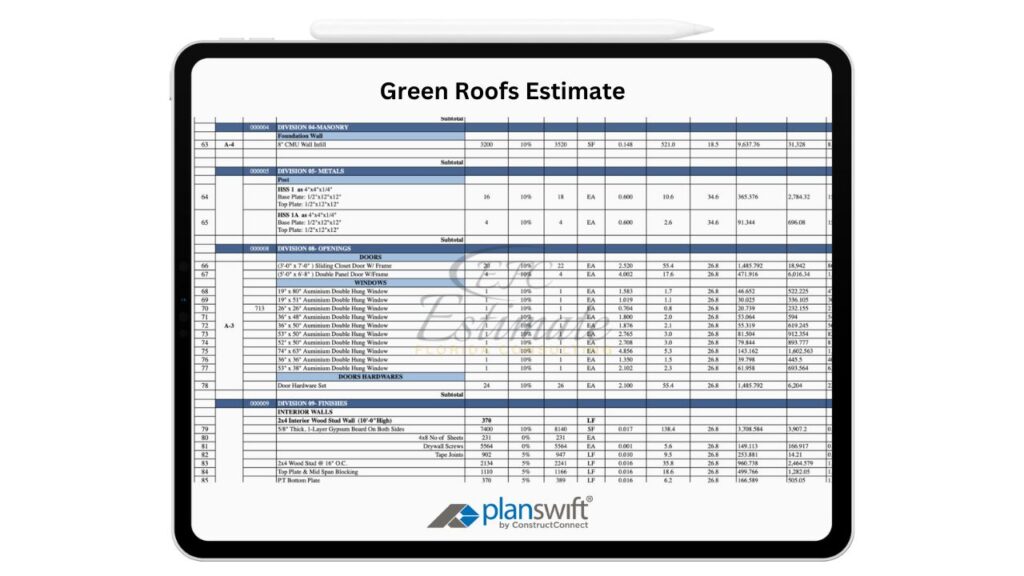
You can expect to spend $10 to $35 per sq.ft. on green roof installation, depending on the type of green roof you choose and what kind of plant coverage you select. Most jobs are priced by the square foot, but there may also be additional charges for design, extra labor that goes above and beyond the “typical” process, and so forth. Usually, you will spend less per sq.ft., and in total, for a more basic green roof than an upgraded biosolar roof, for example. For roofs over 10,000 sq.ft., the cost per sq.ft. could be discounted as much as 50% of what is listed here.
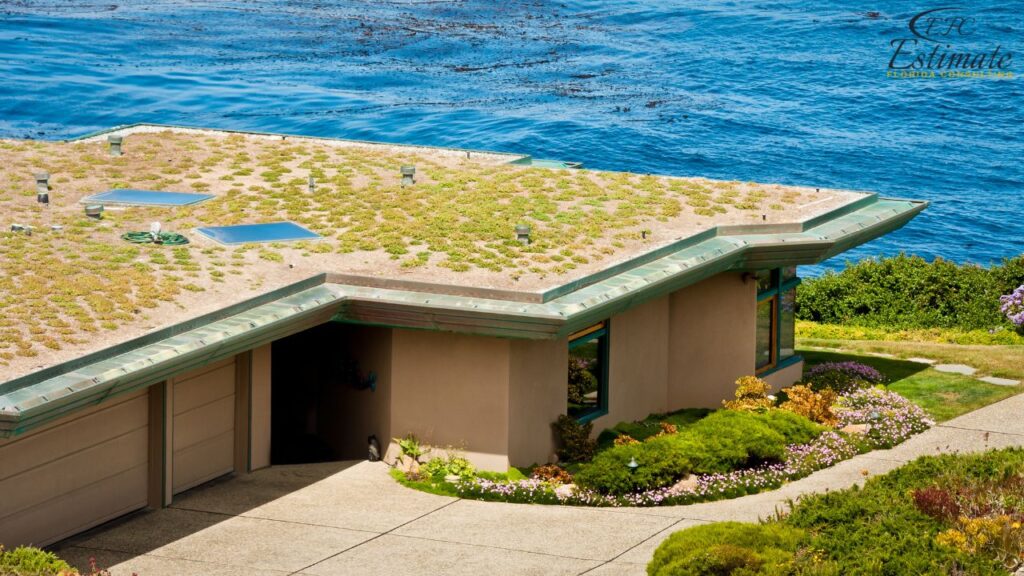
When considering the installation of a green roof, you can expect to spend between $10 and $35 per square foot, depending on the specific type of green roof you choose. Each of the five types has its own unique characteristics, plants, and design considerations, which will influence your overall costs. Below, you’ll find a breakdown of the costs associated with each type of green roof.
Green Roof Type | Cost per Sq.Ft. (Installed) |
Extensive | $10 – $20 |
Semi-Intensive | $15 – $30 |
Intensive | $25 – $35 |
Blue-Green | $25 – $35 |
Biosolar | $25 – $35 |
The extensive green roof is the most popular and affordable option, costing between $10 and $20 per square foot. This type features a thin layer of soil that supports a variety of low-maintenance plants. They are lightweight, making them suitable for roofs with slopes ranging from 0º to 30º. Once established, extensive green roofs require little maintenance and no irrigation, providing excellent value for your investment.
Semi-intensive green roofs typically range from $15 to $30 per square foot. Often referred to as rooftop gardens, these roofs are heavier than extensive roofs and usually feature plants in modular containers rather than allowing them to grow freely. This design enables visitors to stroll through the growing area, but it also necessitates more maintenance and irrigation. Semi-intensive roofs allow for a more curated look and feel.
Intensive green roofs are the most expensive option, costing between $25 and $35 per square foot. These roofs are heavy, featuring a substantial layer of soil that supports a wide variety of plants. Intensive roofs offer the highest level of customization, but they must be installed on flat, concrete structures. Due to their maintenance needs and irrigation requirements, they are better suited for commercial buildings with dedicated maintenance staff, rather than residential properties. However, they can create stunning visual impacts.
The blue-green roof falls within the price range of $25 to $35 per square foot. Designed specifically for urban areas with heavy rainfall, these roofs integrate rainwater management with green roof technology, although they typically have fewer plant options. Blue-green roofs require a flat, sturdy concrete base to support their weight and are not suitable for residential roofs with steep pitches.
Biosolar roofs combine a green roof with solar panel installation, costing between $25 and $35 per square foot for the green roof alone. Additionally, solar panels can add anywhere from $250 to $600 each. This type of roof provides the dual benefits of energy savings and environmental enhancement. Biosolar roofs may be either intensive or semi-intensive and generally utilize modular growing mediums. Due to their weight, they are not commonly installed on residential structures.
When considering a green roof system, you can expect costs to range from $10 to $35 per square foot. The price varies based on the type of system you choose, with built-in or custom-designed roofs typically costing more than modular or tray systems. Your decision may depend on several factors, including the roof’s pitch and your design preferences. Below, you’ll find a detailed cost breakdown for each type of green roof system, along with key considerations to keep in mind.
System Type | Cost per Sq.Ft. (Installed) |
Modular Green Roof | $10 – $30 |
Built-In Green Roof | $20 – $35 |
Modular green roof systems, also known as tray systems, generally cost between $10 and $30 per square foot. They tend to be less expensive than built-in systems, which require more customization and on-site work. While additional labor might be needed to transport materials to the roof, modular systems offer quick and straightforward installation. These tray systems come pre-planted with a variety of hardy plants suitable for green roofing, allowing for a hassle-free setup. While modular systems are faster to install, it’s essential to consider factors like weight and overall cost when making your choice.
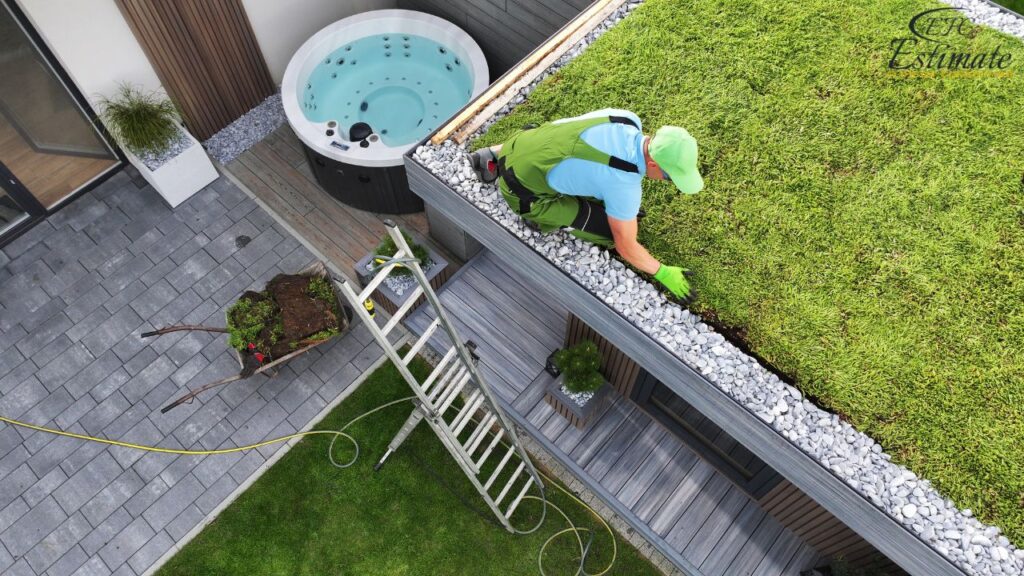
If you opt for a built-in green roof, expect to pay between $20 and $35 per square foot, depending on the complexity of the design and installation. Built-in systems are often lighter and easier to install on standard plywood decks, making them suitable for various roof types, including those with steeper pitches. Unlike modular systems, built-in green roofs are constructed and seeded directly on-site, allowing for a more tailored fit to the roof’s specific design and pitch. This customization can lead to a more aesthetically pleasing and functional green roof, especially for those seeking a unique or intricate design.
For a typical 1,500-square-foot green roof, you can expect the total cost to be around $15,000, with labor accounting for approximately $7,500 of that total. Labor is a significant part of the expense due to the labor-intensive nature of the installation process, which must be performed by a certified Green Roof Professional (GRP). The cost for labor can range from $5 to $10 per square foot, primarily because transporting materials to the roof, constructing the various layers, and planting the vegetation requires considerable time and effort.
Green roofs with steeper pitches or complex designs tend to cost significantly more than simpler roofs, particularly those that use seeds mixed into the growing medium prior to installation. The construction of a green roof involves layering, and every installation should begin with an assessment from a structural engineer to ensure that the roof can support the added weight. Not all roofs are suitable candidates for a green roof, and some may need substantial modifications before installation can occur.
The construction process begins with laying down a protective barrier, typically made of heavy plastic, to prevent plant roots from penetrating the roof deck. If the design includes walls or walking paths, these areas are lined with gravel for added support. Following this, a moisture retention layer, resembling egg crate material, is installed to help retain water. Next, a filter fabric is placed on top to hold the growing media or soil.
Once the filter fabric is in place, soil is added, and the plants are installed. This can be done by sowing seeds, planting seedlings and small plants, or using pre-grown plant trays. The entire installation process usually takes about 5 to 7 days, but it may take several weeks for the plants to fully establish themselves.
The selection of plants for your green roof largely depends on your local climate and environmental conditions. Just like traditional ground plants, the best choices for your green roof will thrive in your area. Common options include wildflowers and sedum, but you can also incorporate grasses and various other plants. Ideal choices often include aromatic herbs, clover, ground covers, and succulents.
For extensive green roofs, it’s important to select plants that can thrive in less than 5 inches of soil. Conversely, intensive green roofs offer a deeper substrate, allowing for plants with deeper root systems. For instance, grasses can flourish on intensive roofs due to the greater soil depth, but may struggle on extensive roofs with shallower soil.
Other factors that influence plant selection include irrigation needs and the primary purpose of the roof, such as energy conservation, stormwater management, or heat reduction. Semi-intensive green roofs provide the flexibility to grow a mix of shallow-rooted and deeper-rooted plants. As urban agriculture gains popularity, many green roofs now feature edible plants like tomatoes, cucumbers, and salad greens, enabling city dwellers to harvest fresh produce right from their rooftops.

While extensive green roofs, commonly found on residential properties, generally don’t require additional watering, semi-intensive and intensive roofs do need an irrigation system. This system should be thoughtfully integrated into the roof’s design to ensure effective drainage and proper watering for all plants. It’s crucial to avoid large puddles of water, which can lead to root rot and other issues.
Irrigation can be achieved through tubing systems and water-retaining mats. Many green roofs utilize drought-resistant plants, like succulents, which can store water and minimize the need for frequent irrigation. In fact, natural rainfall may suffice in many cases, reducing maintenance efforts.
Green roofs offer a multitude of benefits, particularly in urban settings. They can reduce cooling costs for buildings by as much as 25%, effectively managing stormwater runoff in areas prone to heavy rainfall and enhancing air quality on a larger scale. Aesthetic appeal is another significant advantage, with many green roofs requiring minimal maintenance while extending the lifespan of the underlying roof structure.
Despite these benefits, the initial setup costs for a green roof can be substantial. Intensive green roofs, in particular, can only be installed on concrete decks that can support their weight. While the concept of a rooftop garden is appealing, achieving this in many residential settings can be challenging. Additionally, green roofs may lose some visual appeal in winter months, especially if the plants used are not evergreen. Commercial intensive green roofs also necessitate regular maintenance and irrigation to keep them looking their best.
The pitch of your roof is an essential factor in determining which type of green roof system is suitable for your home. Intensive green roofs must be installed on flat concrete roofs (0º pitch), while extensive green roofs can be installed on roofs with pitches up to 30º, though a pitch of less than 20º is ideal. A flatter roof simplifies the installation of the growing medium and plants, making the process smoother and more efficient.
Maintenance costs vary based on the type of green roof you have. For extensive roofs, expect to spend around $0.75 to $1 per square foot annually. Intensive roofs, on the other hand, generally incur maintenance costs ranging from $1 to $1.50 per square foot each year. The level of maintenance required will depend on the type of plants you choose and the roof system you install.
Well-established extensive roofs are relatively low-maintenance, requiring occasional fertilization or watering during drought periods. In contrast, intensive roofs demand more attention. If you have a rooftop garden, you’ll need to maintain it similarly to any other decorative garden bed.
Regular irrigation and monitoring of the drainage system are essential, along with routine inspections to ensure the roof can support the green infrastructure without any moisture problems or leaks.
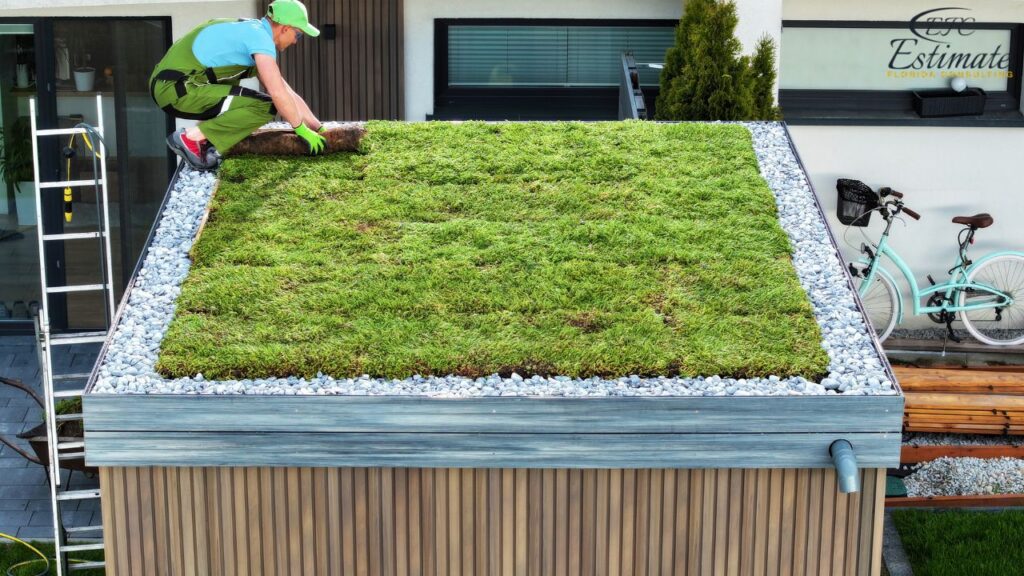
When considering roofing options, it’s essential to compare the costs associated with green roofs and conventional roofs. Green roofs typically range from $15,000 to $30,000, while conventional roofs generally fall between $7,000 and $24,000. The initial investment for green roofs tends to be higher due to increased installation and material costs. However, evaluating both short-term and long-term expenses reveals that green roofs can be a more economical choice over time.
In the short term, the cost of installing a green roof is greater than that of a conventional roof. However, green roofs offer significant long-term benefits that can lead to substantial savings. Here are some key advantages:
The table below summarizes the average installation costs for each roof type:
Roof Type | Average Cost (Installed) |
Conventional Roof | $7,000 – $24,000 |
Green Roof | $15,000 – $30,000 |
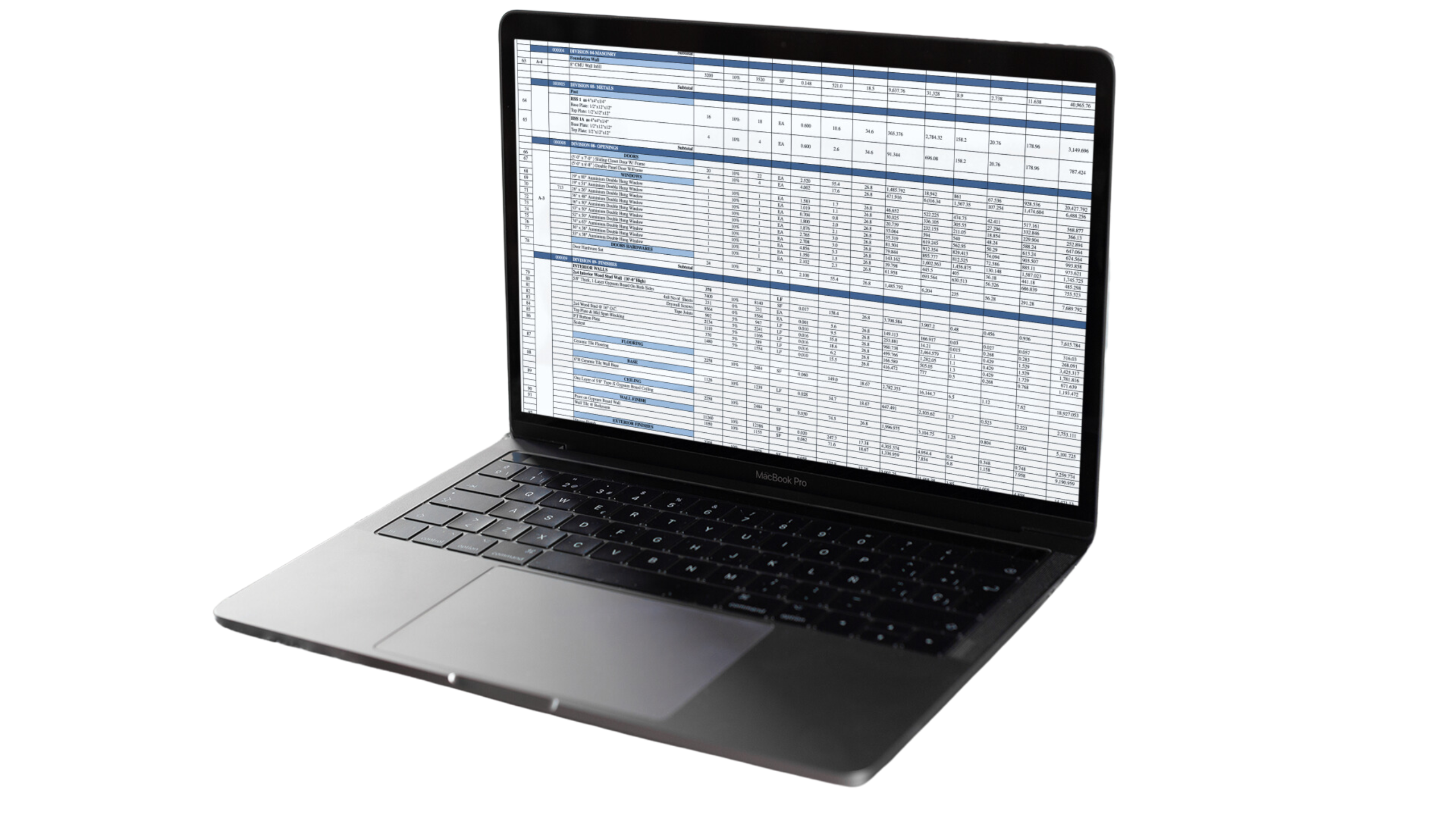
Green roofs can be costly to install initially, ranging from $15,000 to $30,000, depending on the complexity and type of system. Additionally, intensive green roofs require regular maintenance and irrigation, which can add to ongoing costs and effort.
While the upfront costs of green roofs are higher than traditional roofing options, they can be cost-effective in the long run due to energy savings, reduced maintenance costs, and extended roof lifespan. Over time, the benefits may outweigh the initial investment.
A well-installed and maintained green roof can last 30 to 50 years or longer, depending on the materials used and environmental conditions. Proper design and ongoing care are essential for maximizing its lifespan.
Yes, green roofs can enhance property value by improving energy efficiency, offering aesthetic appeal, and contributing to sustainable building practices. They can also make properties more attractive to environmentally conscious buyers.
The maintenance level for green roofs varies by type. Extensive green roofs are low-maintenance and require little irrigation, while intensive roofs require regular care similar to traditional gardens, including irrigation and plant monitoring.
Green roofs face several threats, including potential leaks if not properly installed, structural issues if the underlying roof isn’t assessed correctly, and plant stress during extreme weather conditions. Regular maintenance can mitigate many of these risks.
Green roofs can be less common due to higher installation costs, the need for structural assessment and modification, and the perception that they require more maintenance. Additionally, local building codes and regulations may restrict their implementation.
Alternatives to green roofs include traditional roofing options such as asphalt shingles, metal roofs, or even solar panel installations. Each option has its benefits and drawbacks, depending on budget, aesthetics, and functionality.
While green roofs are generally less prone to leaks due to the protective vegetation and layered construction, improper installation, lack of maintenance, or structural issues can lead to leaks. Regular inspections and maintenance can help prevent this problem.
At Estimate Florida Consulting, we offer detailed cost estimates across all major trades, ensuring no part of your project is overlooked. From the foundation to the finishing touches, our trade-specific estimates provide you with a complete and accurate breakdown of costs for any type of construction project.
We take pride in delivering accurate, timely, and reliable estimates that help contractors and builders win more projects. Our clients consistently praise our attention to detail, fast turnaround times, and the positive impact our estimates have on their businesses.
Estimate Florida Consulting has helped us win more bids with their fast and accurate estimates. We trust them for every project!
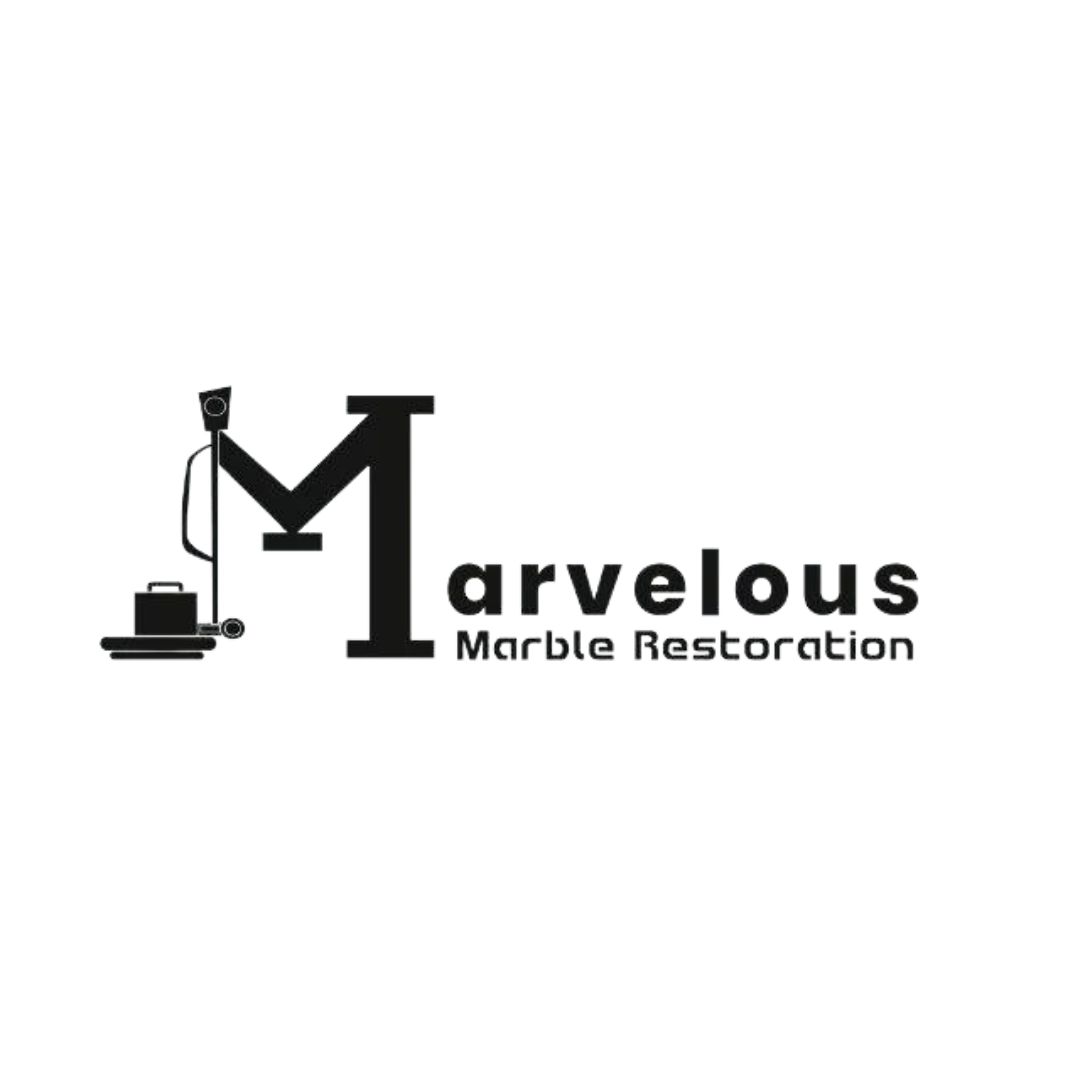
Submit your project plans, blueprints, or relevant documents through our online form or via email.
We’ll review your project details and send you a quote based on your scope and requirements.
Confirm the details and finalize any adjustments to ensure the estimate meets your project needs.
Receive your detailed, trade-specific estimate within 1-2 business days, ready for your project execution.

561-530-2845
info@estimatorflorida.com
Address
5245 Wiles Rd Apt 3-102 St. Pete Beach, FL 33073 United States
561-530-2845
info@estimatorflorida.com
Address
5245 Wiles Rd Apt 3-102 St. Pete Beach, FL 33073 United States
All copyright © Reserved | Designed By V Marketing Media | Disclaimer